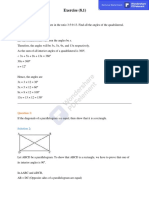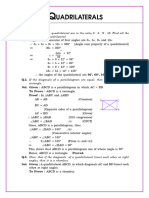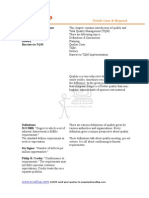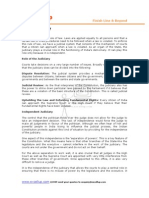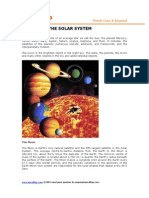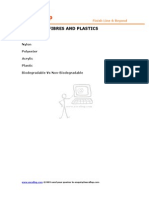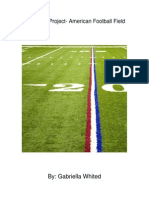9 Math Triangles
9 Math Triangles
Uploaded by
Ajay AnandCopyright:
Available Formats
9 Math Triangles
9 Math Triangles
Uploaded by
Ajay AnandCopyright
Available Formats
Share this document
Did you find this document useful?
Is this content inappropriate?
Copyright:
Available Formats
9 Math Triangles
9 Math Triangles
Uploaded by
Ajay AnandCopyright:
Available Formats
Finish Line & Beyond
CONGRUENCE OF TRIANGLES
1. Two figures are congruent, if they are of the same shape and of the same size.
2. Two circles of the same radii are congruent.
3. Two squares of the same sides are congruent.
4. If two triangles ABC and PQR are congruent under the correspondence A – P,
B-Q and C-R, then symbolically, it is expressed as Δ ABC ≅ Δ PQR.
5. SAS Congruence Rule: If two sides and the included angle of one triangle are
equal to two sides and the included angle of the other triangle, then the two triangles
are congruent. (Axiom: This result cannot be proved with the help of previously
known results.)
6. ASA Congruence Rule: If two angles and the included side of one triangle are
equal to two angles and the included side of the other triangle, then the two triangles
are congruent (ASA Congruence Rule).
Construction: Two triangles are given as follows, where ∠ABC = ∠DEF and
∠ACB = ∠DFE . Sides AB=DE
To Prove: ∆ABC ≅ ∆DEF
Proof: ∠ABC = ∠DEF (given)
AB = DE
AC= DF (Sides opposite to corresponding angles are in the same ratio as ratio
of angles)
Hence, by SAS congruence rule ∆ABC ≅ ∆DEF is proved.
C
B
www.excellup.com ©2009 send your queries to enquiry@excellup.com
Finish Line & Beyond
F
E
7. AAS Congruence Rule: If two angles and one side of one triangle are equal to
two angles and the corresponding side of the other triangle, then the two triangles
are congruent.
This theorem can be proved in similar way as the previous one.
8. Angles opposite to equal sides of a triangle are equal.
9. Sides opposite to equal angles of a triangle are equal.
10. Each angle of an equilateral triangle is of 60°.
11. SSS Congruence Rule: If three sides of one triangle are equal to three sides of
the other triangle, then the two triangles are congruent.
12. RHS Congruence Rule: If in two right triangles, hypotenuse and one side of a
triangle are equal to the hypotenuse and one side of other triangle, then the two tri-
angles are congruent (RHS Congruence Rule).
13. In a triangle, angle opposite to the longer side is larger (greater).
14. In a triangle, side opposite to the larger (greater) angle is longer.
15. Sum of any two sides of a triangle is greater than the third side.
Theorem: Angles opposite to equal sides of an isosceles triangle are equal.
Theorem: The sides opposite to equal angles of a triangle are equal.
Theorem: If two sides of a triangle are unequal, the angle opposite to the longer
side is larger (or greater).
Theorem: In any triangle, the side opposite to the larger (greater) angle is longer.
Theorem: The sum of any two sides of a triangle is greater than the third side.
www.excellup.com ©2009 send your queries to enquiry@excellup.com
Finish Line & Beyond
EXERCISE 1
1. In quadrilateral ACBD, AC = AD and AB bisects C
∠ A. Show that Δ ABC ≅ Δ ABD.
Answer: In ∆ACB & ∆ADB A B
AC=AD
∠CAB = ∠DAB (AB is bisecting ∠CAD )
AB = AB (common side in both triangles)
D
So, by SAS axiom it is proved that;
∆ACB ≅ ∆ADB
2. ABCD is a quadrilateral in which AD = BC and
∠ DAB = ∠ CBA . Prove that
(i) Δ ABD ≅ Δ BAC D
(ii) BD = AC
(iii) ∠ ABD = ∠ BAC.
A
Answer:
(i) In ∆ABD & ∆BAC
AD=BC B
AB=AB (common)
∠BAD = ∠ABC C
So, by SAS rule ∆ABD ≅ ∆BAC
(ii) Since, ∆ABD ≅ ∆BAC ,
so BD = AC
(third corresponding sides of respective triangles). B
C
(iii) In congruent triangles all corresponding angles
Are always equal, so ∠BAD = ∠ABC is proved
O
3. AD and BC are equal perpendiculars to a line
segment AB. Show that CD bisects AB.
D A
Answer: In ∆BOC & ∆AOD
BC=AD (given)
∠CBO = ∠DAO (Right Angle)
∠BOC = ∠AOD (Opposite angles of intersecting lines
So, by ASA rule ∆BOC ≅ ∆AOD
⇒ BO = AO and it is proved that CD bisects AB.
www.excellup.com ©2009 send your queries to enquiry@excellup.com
Finish Line & Beyond
4. l and m are two parallel lines intersected by
p q
another pair of parallel lines p and q. Show that
Δ ABC ≅ Δ CDA.
A l
D
Answer: In ∆ABC & ∆CDA
AB = CD (l and m are parallel)
AD=BC (AB and CD are parallel) m
∠ABC = ∠DCm B C
(Angles on the same side of transversal BC)
∠DCm = ∠ADC (Alternate Angles are equal)
So, ∠ABC = ∠ADC
So, by SAS rule ∆ABC ≅ ∆CDA
5. Line l is the bisector of an angle ∠A and B is any
point on l. BP and BQ are perpendiculars from B
to the arms of ∠A . Show that:
(i) Δ APB ≅ Δ AQB Q l
(ii) BP = BQ or B is equidistant from the arms
of ∠A . B
A P
Answer: In ∆APB & ∆AQB
AB=AB (Common side)
∠PAB = ∠QAB (AB is bisector of ∠QAP )
∠AQB = ∠APB (Right Angle)
So, by ASA rule ∆APB ≅ ∆AQB
And BQ=BP E
A
6. In the given figure, AC = AE, AB = AD and
∠ BAD = ∠ EAC. Show that BC = DE.
Answer: In ∆ABC & ∆ADE
AB=AD (given)
AC=AE (given)
Since, ∠BAD = ∠EAC B D C
So, ∠BAD + ∠DAC = ∠EAC + ∠DAC
Or, ∠BAC = ∠DAE
So, by SAS rule ∆ABC ≅ ∆ADE
⇒ BC = DE proved E
D
7. AB is a line segment and P is its mid-point. D and
E are points on the same side of AB such that
∠ BAD = ∠ ABE and ∠ EPA = ∠ DPB
Show that
(i) Δ DAP ≅ Δ EBP B
A P
(ii) AD = BE
www.excellup.com ©2009 send your queries to enquiry@excellup.com
Finish Line & Beyond
Answer: In∆DAP = ∆EBP D A
∠BAD = ∠ABE (given)
∠EPA = ∠DPB (given)
So, ∠EPA + ∠EPD = ∠DPB + ∠EPD
Or, ∠DPA + ∠EPB
AP=PB (Since P is mid point) M
So, by ASA rule ∆DAP ≅ ∆EBP
So, AD=BE
B C
8. In right triangle ABC, right angled at C, M is
the mid-point of hypotenuse AB. C is joined
to M and produced to a point D such that
DM = CM. Point D is joined to point B.
Show that:
(i) Δ AMC ≅ Δ BMD
(ii) ∠ DBC is a right angle.
(iii) Δ DBC ≅ Δ ACB
1
(iv) CM = AB
2
Answer: In ∆AMC & ∆BMD
BM=AM (M is midpoint)
DM=CM (given)
∠DMB = ∠AMC (opposite angles)
So, ∆AMC ≅ ∆BMD
Hence, DB=AC
∠DBA = ∠BAC
So, DB||AC (alternate angles are equal)
So, ∠BDC = ∠ACB = Right Angle)
(internal angles are complementary in
Case of transversal of parallel lines)
∆DBC & ∆ACB
DB=AC (proved earlier)
BC=BC (Common side)
∠BDC = ∠ACB (proved earlier)
So, ∆DBC ≅ ∆ACB
So, AB=DC
So, AM=BM=CM=DM
1
So, CM= AB
2
www.excellup.com ©2009 send your queries to enquiry@excellup.com
Finish Line & Beyond
EXERCISE 2
1. In an isosceles triangle ABC, with AB = AC,
the bisectors of ∠ B and ∠ C intersect A
each other at O. Join A to O. Show that :
(i) OB = OC (ii) AO bisects ∠ A
Answer: In ∆OBC
∠OBC = ∠OAC (they are half of angles B & C)
O
So, OB=OC ( Sides opposite to equal angles)
In ∆AOB & ∆AOC
AB=AC (given) B C
OB=OC (proved earlier)
∠ABO = ∠ACO (they are half of angles B & C)
So, ∆AOB ≅ ∆AOC (SAS Rule)
A
So, ∠BAO = ∠CAO
It means that AO bisects ∠A
2. In Δ ABC, AD is the perpendicular bisector of BC.
Show that Δ ABC is an isosceles triangle in which
AB = AC.
Answer: In ∆ABD & ∆ACD
B D C
AD=AD (common side)
BD=CD (given)
∠ADB = ∠ADC (right angle)
So, ∆ABD ≅ ∆ACD A
So, AB=AC, which proves that ∆ABC is isosceles
3. ABC is an isosceles triangle in which altitudes
BE and CF are drawn to equal sides AC and AB
F E
respectively. Show that these altitudes are equal.
Answer: In ∆ABE & ∆ACF
AB=AC (given)
∠BAE = ∠CAF (common to both triangles) B C
∠CFA = ∠BEA (right angles)
So, ∆ABE ≅ ∆ACF ( ASA Rule )
So, BE=CF
4. ABC is a triangle in which altitudes BE and CF to
sides AC and AB are equal. Show that
(i) Δ ABE ≅ Δ ACF
(ii) AB = AC, i.e., ABC is an isosceles triangle.
Answer: This can be solved like previous question.
www.excellup.com ©2009 send your queries to enquiry@excellup.com
Finish Line & Beyond
5. ABC and DBC are two isosceles triangles on the same base BC. Show that ∠ ABD
= ∠ ACD.
B C
D
D
Answer: ∠ABC = ∠ACB
∠DBC = ∠DCB
So, ∠ABC + ∠DBC = ∠ACB + ∠DCB
⇒ ∠ABD = ∠ACD A
6. ΔABC is an isosceles triangle in which AB = AC.
Side BA is produced to D such that AD = AB.
Show that ∠ BCD is a right angle. C B
Answer: In ∆ADC & ∆ABC
AD=AB
AC=AC
∠ACB = ∠ABC
∠ACD = ∠ADC
In ΔABC, ∠ACB + ∠ABC + ∠CAB = 180°
⇒ ∠CAB = 180° − 2∠ACB ------------------------------ (1)
Similarly in ΔADC, ∠DAC = 180° − 2∠ACD ------------(2)
As BD is a straight line, so ∠CAB + ∠DAC = 180°
So, adding equations (1)&(2) we get
180° = 360° − 2∠ACB − 2∠ACD
⇒ 180° = 360° − 2(∠ACB + ∠ACD)
⇒ 2(∠ACB + ∠ACD) = 180°
⇒ ∠ACB + ∠ACD = ∠BCD = 90°
7. ABC is a right angled triangle in which ∠ A = 90°
www.excellup.com ©2009 send your queries to enquiry@excellup.com
Finish Line & Beyond
and AB = AC. Find ∠ B and ∠ C.
Answer: If AB= AC then angles opposite to these sides will be equal. As you know
the sum of all angles of a triangle is equal to 180°,
So, ∠ A+ ∠ B+ ∠ C=180°
Or, 90°+ ∠ B+ ∠ C=180°
Or, ∠ B+ ∠ C=180°-90°=90°
Or, ∠ B= ∠ C=90°
8. Show that the angles of an equilateral triangle are 60° each.
Answer: As angles opposite to equal sides of a triangle are always equal. So, in case
of equilateral triangle all angles will be equal. So they will measure one third of 180°,
A P
which is equal to 60°
EXERCISE 3 C Q R
B M N
1. Δ ABC and Δ DBC are two isosceles triangles on
the same base BC and vertices A and D are on the
same side of BC . If AD is extended
to intersect BC at P, show that A
(i) Δ ABD ≅ Δ ACD
(ii) Δ ABP ≅ Δ ACP
(iii) AP bisects ∠ A as well as ∠ D.
(iv) AP is the perpendicular bisector of BC.
A
D
Answer: In ∆ABD & ∆ACD
AB=AC
BD=CD
AD=AD
C
So, Δ ABD ≅ Δ ACD (SSS Rule)
B F E
P
In ∆ABP & ∆ACP
AB=AC
AP=AP
∠ABP = ∠ACP (Angle opposite to equal sides) B C
So, Δ ABP ≅ Δ ACP (SAS Rule)
Since Δ ABP ≅ Δ ACP
So, ∠BAP = ∠CAP
So, AP is bisecting ∠BAC
Similarly ∆BDP & ∆CDP can be proved to be
Congruent and as a result it can be proved that A
AP is bisecting ∠BDC
2. AD is an altitude of an isosceles triangle ABC in
which AB = AC. Show that
www.excellup.com ©2009 send your queries to enquiry@excellup.com
B D C
Finish Line & Beyond
(i) AD bisects BC (ii) AD bisects ∠ A.
Answer: This can be solved like previous question.
3. Two sides AB and BC and median AM
of one triangle ABC are respectively
equal to sides PQ and QR and median
PN of Δ PQR. Show that:
(i) Δ ABM ≅ Δ PQN A
(ii) Δ ABC ≅ Δ PQR
Answer: In ∆ABM & ∆PQN
AB=PQ
B
AM=PN C
BM=QN (median bisects the base)
So, ∆ABM ≅ ∆PQN P Q
In ∆ABC & ∆PQR
AB=PQ
BC=QR
AC=PR (Equal medians means third side will be equal)
So, ∆ABC ≅ ∆PQR
D
4. BE and CF are two equal altitudes of a triangle ABC. B
Using RHS congruence rule, prove that the triangle
ABC is isosceles. O
Answer: In ∆AEB & ∆AFC
BE=CF (Perpendicular) A
AB=BC (Hypotenuse)
C
So, ∆AEB ≅ ∆AFC
5. ABC is an isosceles triangle with AB = AC.
Draw AD ⊥ BC to show that ∠ B = ∠ C.
Answer: After drawing AD ⊥ BC D
In ∆ADC & ∆ADB
AC=AB
AD=AD
∠ADC = ∠ADB
So, ∆ADC ≅ ∆ADB
A
So, ∠ACD = ∠ABC
EXERCISE 4
1. Show that in a right angled triangle, the hypotenuse
is the longest side.
B C
Answer: In a right angled triangle, the angle opposite
To the hypotenuse is 90°, while other two angles are
Always less than 90°. As you know that the side
www.excellup.com ©2009 send your queries to enquiry@excellup.com
Finish Line & Beyond
opposite to the largest angle is always the largest in
a triangle.
2. In the given triangle sides AB and AC of Δ ABC are
extended to points P and Q respectively. Also,
∠ PBC < ∠ QCB. Show that AC > AB.
Answer: ∠ABC = 180° − ∠PBC
∠ACB = 180° − ∠OCB
Since ∠PBC < ∠OCB
So, ∠ABC > ∠ACB
As you know side opposite to the larger angle is larger
than the side opposite to the smaller angle.
Hence, AC>AB
3. In the given figure ∠ B < ∠ A and ∠ C < ∠ D.
Show that AD < BC.
Answer: AO<BO (Side opposite to smaller angle)
DO<CO (Side opposite to smaller angle)
So, AO+DO<BO+CO
Or, AD<BC
4. AB and CD are respectively the smallest and
longest sides of a quadrilateral ABCD. Show that
∠ A > ∠ C and ∠ B > ∠ D.
Answer: Let us draw two diagonals BD and AC as
shown in the figure.
In ΔABD Sides AB<AD<BD
So, ∠ADB < ∠ABD ----------------- (1)
Angle opposite to smaller side is smaller
In ΔBCD Sides BC<DC<BD
So, ∠BDC < ∠CBD ---------------- (2)
Adding equation (1) & (2)
∠ADB + ∠BDC < ∠ABD + ∠CBD
⇒ ∠ADC < ∠ABC
∆ABC
Similarly in
∠BAC > ∠ACB ------------------ (3)
In ∆ADC
∠DAC > ∠DCA ----------------- (4)
Adding equations (3) & (4)
∠BAC + ∠DAC > ∠ACB + ∠DCA
⇒ ∠BAD > ∠BCD
www.excellup.com ©2009 send your queries to enquiry@excellup.com
Finish Line & Beyond
5. In following figure, PR > PQ and PS bisects ∠ QPR. Prove that ∠ PSR > ∠ PSQ.
4 5
3
1 2
Q R
S
Answer: For convenience let us name these angles as follows:
∠PQR = 1
∠PRQ = 2
∠QPR = 3
∠QPS = 4
∠RPS = 5
∠PSQ = 6
∠PSR = 7
Since, PR>PQ , so ∠1 > ∠2
In ∆PQS
∠1 + ∠4 + ∠6 = 180°
In ∆PRS
∠2 + ∠5 + ∠7 = 180°
In both these triangles
∠4 = ∠5
∠1 > ∠2
So, for making the sum total equal to 180° the following will always be true:
∠6 < ∠7
www.excellup.com ©2009 send your queries to enquiry@excellup.com
You might also like
- List of Proof Reasons - REVISEDDocument4 pagesList of Proof Reasons - REVISEDJayRRomeo83% (6)
- 8-Quadrilaterals - Q + SonDocument29 pages8-Quadrilaterals - Q + SonKanampalli KrishnamurthyNo ratings yet
- Ncert Sol For Class 9 Maths Chapter 8Document15 pagesNcert Sol For Class 9 Maths Chapter 8NiranjanNo ratings yet
- NCERT Solutions For Class 9 Maths Chapter 8 Quadrilaterals Exercise 8.1Document9 pagesNCERT Solutions For Class 9 Maths Chapter 8 Quadrilaterals Exercise 8.1triptiNo ratings yet
- TrianglesDocument17 pagesTrianglesKamlesh MaharanaNo ratings yet
- Quadilateral Solved QuestionDocument21 pagesQuadilateral Solved Questionminazabbasi130No ratings yet
- NCERT Solutions For Class 9 Maths Chapter 7 Geometry of TrianglesDocument21 pagesNCERT Solutions For Class 9 Maths Chapter 7 Geometry of Trianglessuresh muthuramanNo ratings yet
- Exercise (8.1) : Solution 1Document24 pagesExercise (8.1) : Solution 1Samyak ParakhNo ratings yet
- Exercise (8.1) : Solution 1Document24 pagesExercise (8.1) : Solution 1Samyak ParakhNo ratings yet
- CH 7Document30 pagesCH 7Sardar HundalNo ratings yet
- NCERT Solutions For Class 9 Maths Chapter 7 TrianDocument3 pagesNCERT Solutions For Class 9 Maths Chapter 7 Triansujalverma4774No ratings yet
- NCERT Solutions For Class 9 Maths Chapter 7 Geometry of Triangles Exercise 7 1Document6 pagesNCERT Solutions For Class 9 Maths Chapter 7 Geometry of Triangles Exercise 7 1anitaannu974No ratings yet
- NCERT Solutions For Class 9 Maths Chapter 8 Quadrilaterals Exercise 8 1Document14 pagesNCERT Solutions For Class 9 Maths Chapter 8 Quadrilaterals Exercise 8 1rudratrivedi011No ratings yet
- Triangle TestDocument6 pagesTriangle Testvineet22rajputNo ratings yet
- Chapter 7 Triangles Ex 7Document24 pagesChapter 7 Triangles Ex 7Himanshu JethwaniNo ratings yet
- Chapter 8Document32 pagesChapter 8anuarusheducationNo ratings yet
- FC4A4CDD-18F2-46C4-985B-1979FBFCB60DDocument14 pagesFC4A4CDD-18F2-46C4-985B-1979FBFCB60DNight FuryNo ratings yet
- 8920003-CL09 - WS2 - Triangle - Shiji - 2022-23Document6 pages8920003-CL09 - WS2 - Triangle - Shiji - 2022-23hannahNo ratings yet
- Concise Selina Solutions For Class 9 Maths Chapter 9 TrianglesDocument31 pagesConcise Selina Solutions For Class 9 Maths Chapter 9 Trianglestanya.a.s.0825No ratings yet
- P6 Qewkp 7 LI2 Ri AQc MF MRDocument12 pagesP6 Qewkp 7 LI2 Ri AQc MF MRharjotsinghuppalsNo ratings yet
- NCERT Solutions For Class 9 Maths Chapter 7 Geometry of Triangles Exercise 7 3Document4 pagesNCERT Solutions For Class 9 Maths Chapter 7 Geometry of Triangles Exercise 7 3shubhamdubey1270No ratings yet
- Class X Solutions (CH-6,7& 14)Document12 pagesClass X Solutions (CH-6,7& 14)harpalrana01.hrNo ratings yet
- Maths Ixb KeyDocument6 pagesMaths Ixb KeyMurshid CeeNo ratings yet
- Ncert Sol For Class 9 Maths Chapter 7Document22 pagesNcert Sol For Class 9 Maths Chapter 7VANSHNo ratings yet
- Quadrilaterals 9th PDFDocument30 pagesQuadrilaterals 9th PDFINDUS Detergents & Soap OilNo ratings yet
- Assignment: Congruent Triangles - 4Document12 pagesAssignment: Congruent Triangles - 4UNKNOWN LEGENDNo ratings yet
- Chapter 15Document45 pagesChapter 15tirumalaNo ratings yet
- NCERT Solutions For Class 9th QuadrilateralsDocument15 pagesNCERT Solutions For Class 9th QuadrilateralsjobztexNo ratings yet
- Here You Will Get Following Materials:-: All Study Materials in Free of CostDocument18 pagesHere You Will Get Following Materials:-: All Study Materials in Free of CostMohd ShahbazNo ratings yet
- RS Aggarwal Class 9 Maths Chapter 9Document49 pagesRS Aggarwal Class 9 Maths Chapter 9pranshia03No ratings yet
- NCERT Solutions For Class 10 Maths Chapter 6 Triangles Exercise 6.3Document14 pagesNCERT Solutions For Class 10 Maths Chapter 6 Triangles Exercise 6.3krishan murariNo ratings yet
- Triangles (2) MergedDocument73 pagesTriangles (2) Mergedsujayofficial.studentNo ratings yet
- Congruence of TrianglesDocument33 pagesCongruence of Trianglesptv7105No ratings yet
- NCERT Exemplar For Class 10 Maths Chapter 6 - Triangles (Book Solutions)Document85 pagesNCERT Exemplar For Class 10 Maths Chapter 6 - Triangles (Book Solutions)bansalkayanNo ratings yet
- Ncert Exemplar Math Class 09 Chapter 08 QuadrilateralsDocument28 pagesNcert Exemplar Math Class 09 Chapter 08 QuadrilateralsPRANAT JAIN VII DNo ratings yet
- Triangle 5Document11 pagesTriangle 5Vilas ShindeNo ratings yet
- Triangles: CongruenceDocument17 pagesTriangles: CongruencenilaNo ratings yet
- Maths notes-tringles-IXDocument33 pagesMaths notes-tringles-IXNeelesh BaghelNo ratings yet
- QuadrilateralsDocument12 pagesQuadrilateralsAmar ShandliyaNo ratings yet
- TrianglesDocument13 pagesTrianglesgranthanmolNo ratings yet
- Maths Ix A KeyDocument6 pagesMaths Ix A KeyMurshid CeeNo ratings yet
- Practical BookDocument29 pagesPractical Bookrajakhan23346yyNo ratings yet
- NCERT Solution For Class 10 Maths Chapter 6 Triangles Exercise 6.3Document13 pagesNCERT Solution For Class 10 Maths Chapter 6 Triangles Exercise 6.3Deeptanu ShilNo ratings yet
- Triangles Worksheet 2024Document6 pagesTriangles Worksheet 2024pereiraclaudia0713No ratings yet
- Solution of TrianglesDocument57 pagesSolution of TrianglesAvishkar JaiswalNo ratings yet
- Similar Triangles: Chapter - 8Document23 pagesSimilar Triangles: Chapter - 8ALLU SRI SAINo ratings yet
- Similarity (With Applications To Maps and Models)Document83 pagesSimilarity (With Applications To Maps and Models)haseebmuhammed786687No ratings yet
- Mathematics Part-3 of 4Document67 pagesMathematics Part-3 of 4Sankalp Akash Singh0% (1)
- Triangles - Class 10 - Notes - PANTOMATHDocument8 pagesTriangles - Class 10 - Notes - PANTOMATHsourav9823100% (1)
- Practice Sheet Triangle SPRINT-OnE SHORT Dimple Mam Rohit PDFDocument6 pagesPractice Sheet Triangle SPRINT-OnE SHORT Dimple Mam Rohit PDFaashishkumarupadhyay38No ratings yet
- Ncert Solutions Class 9 Math Chapter 8 Quadrilaterals Ex 8 1Document18 pagesNcert Solutions Class 9 Math Chapter 8 Quadrilaterals Ex 8 1NGlobal ConsultantsNo ratings yet
- Ix Maths Chapter 8 QuadrilateralsDocument20 pagesIx Maths Chapter 8 QuadrilateralsDVAC-SERVER100% (1)
- Geometry: 1 Congruent TrianglesDocument2 pagesGeometry: 1 Congruent TrianglesRomario TambunanNo ratings yet
- Class 9th Solved Questions Chapter QuadrilateralDocument7 pagesClass 9th Solved Questions Chapter QuadrilateralSASIKALA RAVICHANDRANNo ratings yet
- Geometric Proofs: Notation MeaningDocument14 pagesGeometric Proofs: Notation Meaningskat0003No ratings yet
- Geomatry QuestionsDocument7 pagesGeomatry Questionsmanickavasagams1688No ratings yet
- 09 Maths ch8 tp1Document7 pages09 Maths ch8 tp1Ranjan RoyNo ratings yet
- Congruence Teachers GuideDocument23 pagesCongruence Teachers GuidejaterNo ratings yet
- 10+2 Level Mathematics For All Exams GMAT, GRE, CAT, SAT, ACT, IIT JEE, WBJEE, ISI, CMI, RMO, INMO, KVPY Etc.From Everand10+2 Level Mathematics For All Exams GMAT, GRE, CAT, SAT, ACT, IIT JEE, WBJEE, ISI, CMI, RMO, INMO, KVPY Etc.No ratings yet
- Definitions & Dimensions Planning Quality Costs TQM History Barriers To TQMDocument10 pagesDefinitions & Dimensions Planning Quality Costs TQM History Barriers To TQMAjay AnandNo ratings yet
- Finish Line & BeyondDocument7 pagesFinish Line & BeyondAjay Anand100% (1)
- Preview of Satires in ShortDocument2 pagesPreview of Satires in ShortAjay AnandNo ratings yet
- Finish Line & BeyondDocument4 pagesFinish Line & BeyondAjay AnandNo ratings yet
- 8 SocSc RulingtheCountrysideDocument6 pages8 SocSc RulingtheCountrysideBalqis SalamaNo ratings yet
- 8 SocSc JudiciaryDocument4 pages8 SocSc JudiciaryAjay AnandNo ratings yet
- Finish Line & BeyondDocument7 pagesFinish Line & BeyondAjay AnandNo ratings yet
- 8 Social Science ResourcesDocument3 pages8 Social Science ResourcesAjay AnandNo ratings yet
- Finish Line & BeyondDocument3 pagesFinish Line & BeyondAjay AnandNo ratings yet
- Finish Line & BeyondDocument4 pagesFinish Line & BeyondAjay AnandNo ratings yet
- Finish Line & BeyondDocument4 pagesFinish Line & BeyondAjay AnandNo ratings yet
- ElectrolysisDocument4 pagesElectrolysisJaskirat SinghNo ratings yet
- Finish Line & BeyondDocument4 pagesFinish Line & BeyondAjay AnandNo ratings yet
- 8 Science MicroorganismsDocument6 pages8 Science MicroorganismsAjay AnandNo ratings yet
- 8 Science Stars&SolarSystemDocument7 pages8 Science Stars&SolarSystemAjay AnandNo ratings yet
- 8 Science Air&WaterPollutionDocument5 pages8 Science Air&WaterPollutionAjay AnandNo ratings yet
- 8 Science Synthetic FibresDocument4 pages8 Science Synthetic FibresHarun VenkatNo ratings yet
- 8 Science CellDocument6 pages8 Science CellRizky AlfarizyNo ratings yet
- 8 Math MensurationDocument18 pages8 Math MensurationAjay Anand100% (1)
- 8 Math QuadrilateralsDocument16 pages8 Math QuadrilateralsAjay AnandNo ratings yet
- 8 Math Rational NumbersDocument8 pages8 Math Rational NumbersAjay AnandNo ratings yet
- Clark, H.H. Semantics and Comprehension - 1974 PDFDocument139 pagesClark, H.H. Semantics and Comprehension - 1974 PDFAzza AhmedNo ratings yet
- Robin Hartshorne Geometry - Euclid and Beyond (PDFDrive)Document535 pagesRobin Hartshorne Geometry - Euclid and Beyond (PDFDrive)Chí NgôNo ratings yet
- IGCSE Geometry Questions MSDocument12 pagesIGCSE Geometry Questions MSAntonia MateosNo ratings yet
- Proving Properties of Parallel Lines Cut by A TransversalDocument13 pagesProving Properties of Parallel Lines Cut by A TransversalKruza100% (1)
- Gvasol 2Document62 pagesGvasol 2afaflotfi_155696459No ratings yet
- Instant Download Mathematics For Elementary Teachers: A Conceptual Approach Tenth Edition. Edition Bennett PDF All ChapterDocument62 pagesInstant Download Mathematics For Elementary Teachers: A Conceptual Approach Tenth Edition. Edition Bennett PDF All Chapterlonnbuguet100% (3)
- Overview of Taxicab GeometryDocument2 pagesOverview of Taxicab Geometryapi-255059274No ratings yet
- Lesson 1: Why Move Things Around?: Student OutcomesDocument8 pagesLesson 1: Why Move Things Around?: Student OutcomesDanny Riel BarachinaNo ratings yet
- pp1 MathDocument16 pagespp1 Mathnoah.mainanNo ratings yet
- DLP Math 8 Equality and Congruence PropertyDocument9 pagesDLP Math 8 Equality and Congruence PropertyRujhon Nabablit BahallaNo ratings yet
- G5 C11 TestDocument6 pagesG5 C11 TestvictoriaNo ratings yet
- Final Mode ContinuumDocument21 pagesFinal Mode Continuumapi-282747600No ratings yet
- Q3 Grade 8 Week 6Document15 pagesQ3 Grade 8 Week 6aniejeonNo ratings yet
- 12.3 - Segment Addition Lesson PlanDocument3 pages12.3 - Segment Addition Lesson Plansunita agreyNo ratings yet
- Annotated Lesson PlanDocument2 pagesAnnotated Lesson Planapi-251092281No ratings yet
- Math 8 - Proofing (Direct and Indirect) : Ms. Andi Fullido © QuipperDocument14 pagesMath 8 - Proofing (Direct and Indirect) : Ms. Andi Fullido © QuipperZyra Milky Araucto SisonNo ratings yet
- MMW Chapter 3Document82 pagesMMW Chapter 3Marjorie MalvedaNo ratings yet
- Goemtryننفرد بنشر الشيت الأفضل للأول الإعدادى لغات ترم أول 2014Document10 pagesGoemtryننفرد بنشر الشيت الأفضل للأول الإعدادى لغات ترم أول 2014deyaa1000000No ratings yet
- Answer Key - CK-12 Chapter 06 Geometry Honors Concepts (Revised)Document9 pagesAnswer Key - CK-12 Chapter 06 Geometry Honors Concepts (Revised)Gabriella FordNo ratings yet
- FootballDocument3 pagesFootballapi-208349712No ratings yet
- Module2 Circles 130825092956 Phpapp02 PDFDocument24 pagesModule2 Circles 130825092956 Phpapp02 PDFPia Diobela ManlapigNo ratings yet
- Wa0004.Document239 pagesWa0004.Abhishek meenaNo ratings yet
- Geo Free SessionDocument197 pagesGeo Free SessionsushantNo ratings yet
- Math Cheat SheetDocument37 pagesMath Cheat SheetBuzz OldwretchNo ratings yet
- Grade 10 Math NotesDocument14 pagesGrade 10 Math NotesJohnNo ratings yet
- Year 9 Accelerated Test 4 - Congruence and Similarity CH 5 2012Document8 pagesYear 9 Accelerated Test 4 - Congruence and Similarity CH 5 2012api-241203104No ratings yet
- Complete (Ebook PDF) Mathematics For Elementary School Teachers: A Process Approach PDF For All ChaptersDocument41 pagesComplete (Ebook PDF) Mathematics For Elementary School Teachers: A Process Approach PDF For All Chapterslasoensajru100% (3)
- Class 9-GeometryDocument6 pagesClass 9-GeometryShashiNo ratings yet
- Esolutions Manual - Powered by CogneroDocument26 pagesEsolutions Manual - Powered by CogneroCarl Michael JaudianNo ratings yet








